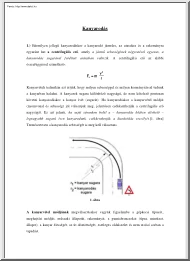Datasheet
Year, pagecount:2016, 2 page(s)
Language:English
Downloads:5
Uploaded:October 21, 2019
Size:553 KB
Institution:
-
Comments:
courteoustravel.com
Attachment:-
Download in PDF:Please log in!
Comments
No comments yet. You can be the first!Most popular documents in this category
Content extract
Source: http://www.doksinet http://www.courteoustravelcom facebook twitter 100% Electric Vehicles as taxis? We recently undertook a feasibility study to see if it would be viable for us, a private hire company to utilise 100% electric vehicles. Weve tried to use petrol/diesel terminology alongside the EV terminology “Filling up” How easy is it to find a charging point? Charging of electric vehicles isnt too much of a problem these days. Currently there are over 10,000 charging points in the UK of which more than 200 are rapid chargers located at most motorway service stations, most airport car parks, some stores such as Ikea and even car dealers such as Nissan. One can also have charging points fitted at home – optional extra with some car dealers. How long does it take to charge an EV (Electric Vehicle) Charging at home or on a normal charging point can take from 5 hours upwards depending on the charging point fitted at home or, if using a rapid charging point, it can take
as little as 30 minutes to charge an EV. What is a “rapid charging point”? A rapid charger does exactly what it says on the box, and will charge a Nissan Leaf for instance, in the time it would take to enjoy a cup of coffee at a service station. How much does it cost to “fill up” an EV (fully charge it)? If youre using “Ecotricity” charging points located at most motorway service stations, Ikea stores etc, then it could be free if you switch your energy supply to Ecotricity. If you are picking passengers up from an airport, such as Heathrow Airport (with over 30 charging points in the short stay car parks) and Gatwick Airport (with 8 charging points in the short stay car parks), then it is also free to use as well. Whats the “fuel range” on an EV? This is where things started to go wrong for us. Out of the vehicles we looked at, only one could be considered usable as a private hire vehicle given our geographic location and our daily mileage per vehicle. The Nissan Leaf
has a range of up to 155 miles between charge. The BMW i3 has a range of up to 125 miles between charge. The Renault Zoe has a range of up to 149 miles between charge. The “up to” are the key words and as is mentioned on the Renault website under “technical specifications” “electric power”, the real world figure is actually up to 106 miles in the summer and up to 71 miles in the winter and not 149 miles. We must congratulate Renault for stating this clearly on their website Whilst the electric vehicle technology has evolved considerably over the last few years, especially the battery technology, we have had to discount all vehicles we looked at with the exception of the Tesla due to their limited range. The Tesla on the other hand, with its claimed range of up to 357 miles for the Model S seamed like a viable proposition despite its high value as, the higher finance costs would be offset by the substantial cost savings made on fuel given the fact that, currently one can
charge an electric vehicle for free at the majority of charging points. However, even the Tesla range is debatable as, the 357 mile range above mentioned is assuming one goes for the Tesla Model S P90D fitted with 19” wheels driving at 55 mph with an air temperature of 20 degrees Celsius. If you opt for the 21” wheels, then the range drops to 340 miles, which is still admirable Increase your speed to 70 mph (motorway and dual carriageway speed limit), the range drops to 294 miles Page 1 of 2 Source: http://www.doksinet http://www.courteoustravelcom facebook twitter and 281 miles respectively for the 19” and 21” wheels. Roll on winter, turn your heater on etc and the range drops further to 231 miles and 221 miles respectively. Even with this huge drop in range, the Tesla still makes it a theoretical viable proposition to use as a private hire vehicle as one can drop a customer at an airport or cruise terminal and get back to base on one charge if needed, or one could stop at
a service station enroute for a cup of coffee and break and charge the vehicle without having to deviate from the route to find a charging point. So why did we say “.seamed like a viable proposition”? Well, for now, weve also discounted the Tesla as the fuel range figures are based on the 90kWh battery fitted with all wheel drive which pushes the cost of the vehicle even further. Additionally, as with all EVs, you dont actually own the battery, only the vehicle. The battery has to be rented for a monthly premium. Conclusion If one were living in a big city such as London, then any of these vehicles would be suitable for a private individual and, the Tesla for a private hire company as well but for now, we will wait and will instead look at hybrid vehicles. September 6th, 2016 Page 2 of 2
as little as 30 minutes to charge an EV. What is a “rapid charging point”? A rapid charger does exactly what it says on the box, and will charge a Nissan Leaf for instance, in the time it would take to enjoy a cup of coffee at a service station. How much does it cost to “fill up” an EV (fully charge it)? If youre using “Ecotricity” charging points located at most motorway service stations, Ikea stores etc, then it could be free if you switch your energy supply to Ecotricity. If you are picking passengers up from an airport, such as Heathrow Airport (with over 30 charging points in the short stay car parks) and Gatwick Airport (with 8 charging points in the short stay car parks), then it is also free to use as well. Whats the “fuel range” on an EV? This is where things started to go wrong for us. Out of the vehicles we looked at, only one could be considered usable as a private hire vehicle given our geographic location and our daily mileage per vehicle. The Nissan Leaf
has a range of up to 155 miles between charge. The BMW i3 has a range of up to 125 miles between charge. The Renault Zoe has a range of up to 149 miles between charge. The “up to” are the key words and as is mentioned on the Renault website under “technical specifications” “electric power”, the real world figure is actually up to 106 miles in the summer and up to 71 miles in the winter and not 149 miles. We must congratulate Renault for stating this clearly on their website Whilst the electric vehicle technology has evolved considerably over the last few years, especially the battery technology, we have had to discount all vehicles we looked at with the exception of the Tesla due to their limited range. The Tesla on the other hand, with its claimed range of up to 357 miles for the Model S seamed like a viable proposition despite its high value as, the higher finance costs would be offset by the substantial cost savings made on fuel given the fact that, currently one can
charge an electric vehicle for free at the majority of charging points. However, even the Tesla range is debatable as, the 357 mile range above mentioned is assuming one goes for the Tesla Model S P90D fitted with 19” wheels driving at 55 mph with an air temperature of 20 degrees Celsius. If you opt for the 21” wheels, then the range drops to 340 miles, which is still admirable Increase your speed to 70 mph (motorway and dual carriageway speed limit), the range drops to 294 miles Page 1 of 2 Source: http://www.doksinet http://www.courteoustravelcom facebook twitter and 281 miles respectively for the 19” and 21” wheels. Roll on winter, turn your heater on etc and the range drops further to 231 miles and 221 miles respectively. Even with this huge drop in range, the Tesla still makes it a theoretical viable proposition to use as a private hire vehicle as one can drop a customer at an airport or cruise terminal and get back to base on one charge if needed, or one could stop at
a service station enroute for a cup of coffee and break and charge the vehicle without having to deviate from the route to find a charging point. So why did we say “.seamed like a viable proposition”? Well, for now, weve also discounted the Tesla as the fuel range figures are based on the 90kWh battery fitted with all wheel drive which pushes the cost of the vehicle even further. Additionally, as with all EVs, you dont actually own the battery, only the vehicle. The battery has to be rented for a monthly premium. Conclusion If one were living in a big city such as London, then any of these vehicles would be suitable for a private individual and, the Tesla for a private hire company as well but for now, we will wait and will instead look at hybrid vehicles. September 6th, 2016 Page 2 of 2





 Just like you draw up a plan when you’re going to war, building a house, or even going on vacation, you need to draw up a plan for your business. This tutorial will help you to clearly see where you are and make it possible to understand where you’re going.
Just like you draw up a plan when you’re going to war, building a house, or even going on vacation, you need to draw up a plan for your business. This tutorial will help you to clearly see where you are and make it possible to understand where you’re going.